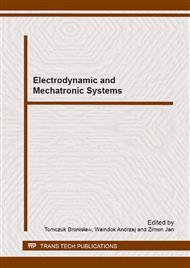[1]
K. Tokarz, S. Kiełtyka, Geometric approach to inverse kinematics for arm manipulator, Latest trends on systems, 14th WSEAS International Conference on Systems, Corfu, vol. II (2010) 682-687.
Google Scholar
[2]
K. Tokarz, C. Manger, Geometric and rough set approach to inverse kinematics for arm manipulator, International Journal of Mathematical Models and Methods in Applied Sciences, 5 (1), NAUN (2011) 1-8.
Google Scholar
[3]
G. Borenstein, Making Things See – 3D vision with Kinect, Processing, Arduino, and MakerBot, O'Reilly Media, 2012.
Google Scholar
[4]
Kinect Open Source programming secrets: Java programming tutorial for Kinect, http://fivedots.coe.psu.ac.th/~ad/kinect/
Google Scholar
[5]
OpenNI: OpenNI documentation, http://openni.org/Documentation/
Google Scholar
[6]
Microsoft: MSDN site with Kinect specification, http://msdn.microsoft.com/en-us/library/hh855348.aspx
Google Scholar
[7]
T. Grzejszczak, M. Mikulski, T. Szkodny, K. Jędrasiak, Gesture Based Robot Control, Proceedings of International conference Computer vision and graphics. ICCVG 2012, Warsaw, Poland, September 24-26, 2012., pp.407-413, Lecture Notes in Computer Science; vol. 7594 Springer, Berlin, 2012.
DOI: 10.1007/978-3-642-33564-8_49
Google Scholar
[8]
B. Bagnal, Maximum LEGO NXT: Building Robots with Java Brains, 3rd edition, (2012)
Google Scholar
[9]
NASA ISS, Filming of Space Robot "Jitter" Assembled out of Legos (Konstructor), http://www.nasa.gov/mission_pages/station/research/experiments/Konstructor.html#description, 2012.
Google Scholar
[10]
The LEGO Group: LEGO Mindstorms NXT Communication Protocol, Bluetooth Development Kit, 2006.
Google Scholar
[11]
The LEGO Group: 8527 – T-56 Building Manual, http://mindstorms.lego.com/en-us/support/buildinginstructions/8527-/T-56.aspx, 2010.
Google Scholar
[12]
P. Hurbain, NXT motor characteristics: http://www.philohome.com/nxtmotor/nxtmotor.htm, 2013.
Google Scholar
[13]
PrimeSense, http://www.primesense.com/, 2013.
Google Scholar
[14]
LEGO Mindstorms, http://mindstorms.lego.com, 2013.
Google Scholar
[15]
NXT Intelligent Brick, http://en.wikipedia.org/wiki/Lego_Mindstorms_NXT#NXT_Intelligent_Brick, 2013.
DOI: 10.3888/tmj.15-3
Google Scholar
[16]
Tracking Modes (Seated and Default), http://msdn.microsoft.com/en-us/library/hh973077.aspx, 2013.
Google Scholar
[17]
3Gear gesture PC control, http://www.threegear.com/, 2013.
Google Scholar
[18]
Controlling robots using wrist band – MYO. https://developer.thalmic.com/apply/, 2013.
Google Scholar
[19]
Codasign, http://learning.codasign.com/index.php?title=Skeleton_Tracking_with_the_Kinect, 2013.
Google Scholar
[20]
PrimeSense Middleware, http://www.primesense.com/solutions/nite-middleware/, 2013.
Google Scholar
[21]
Microsoft Corporation, Kinect for Windows. Human Interface Guidelines, http://msdn.microsoft.com/en-us/library/jj663791.aspx, v1.8, 2014.
Google Scholar


